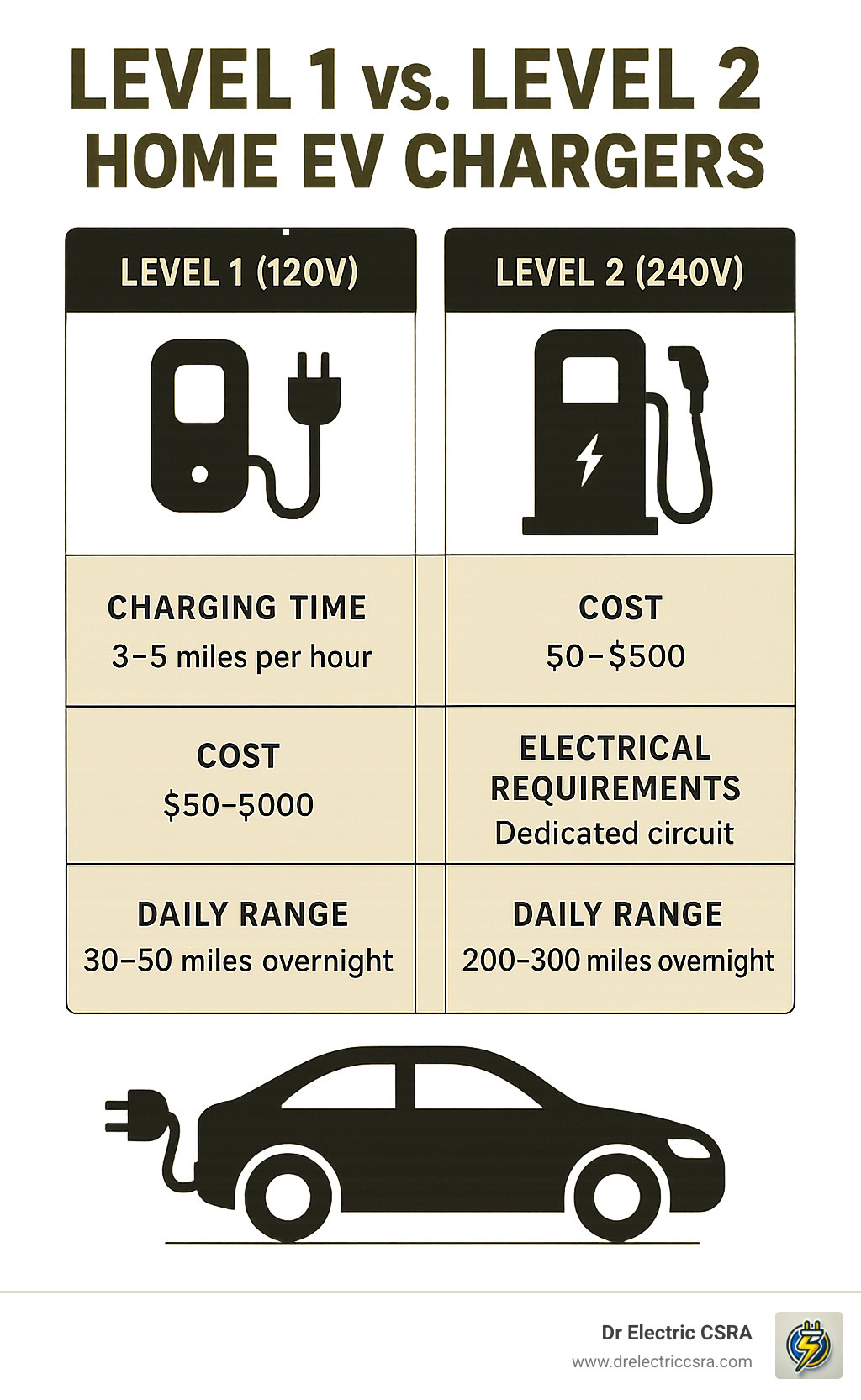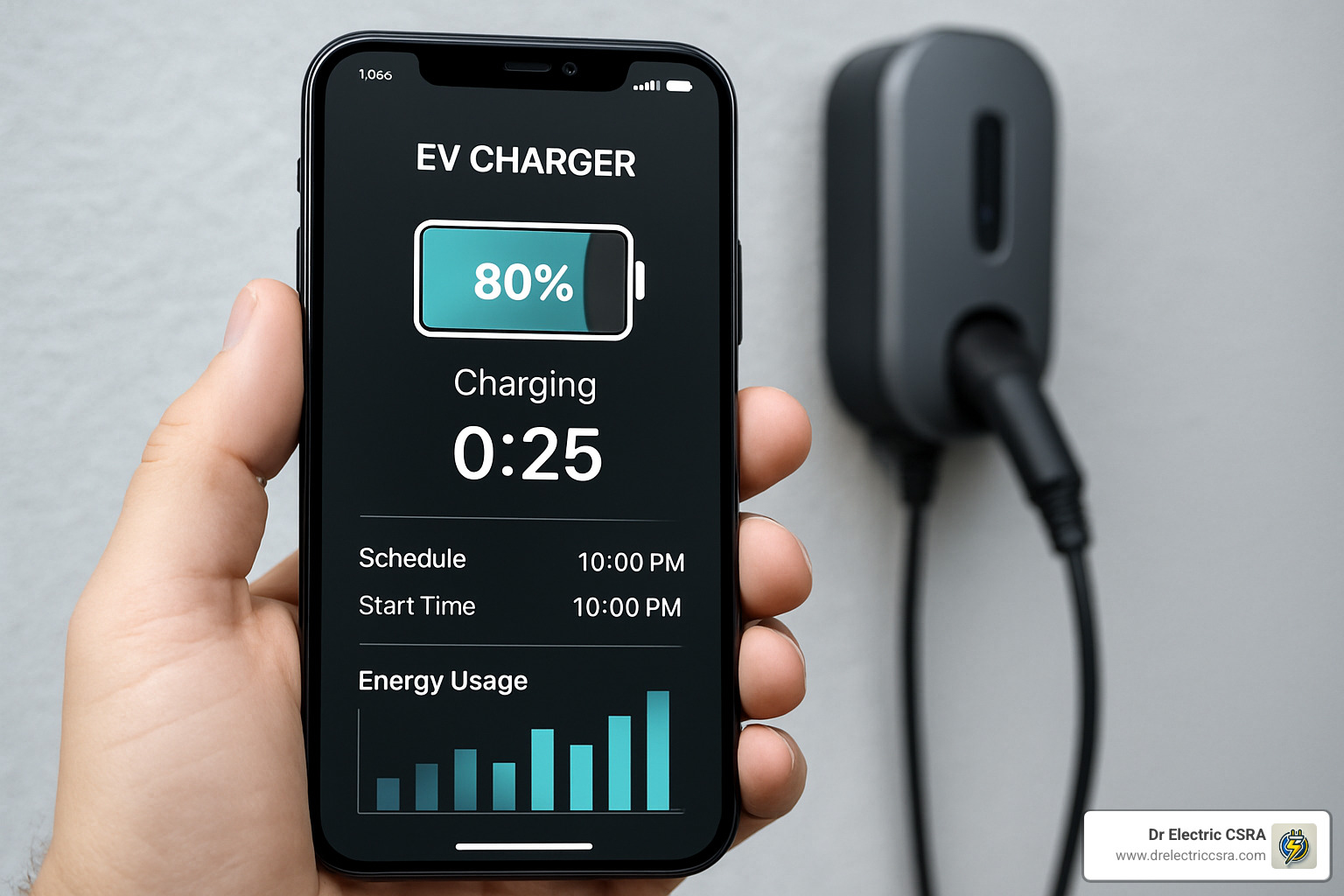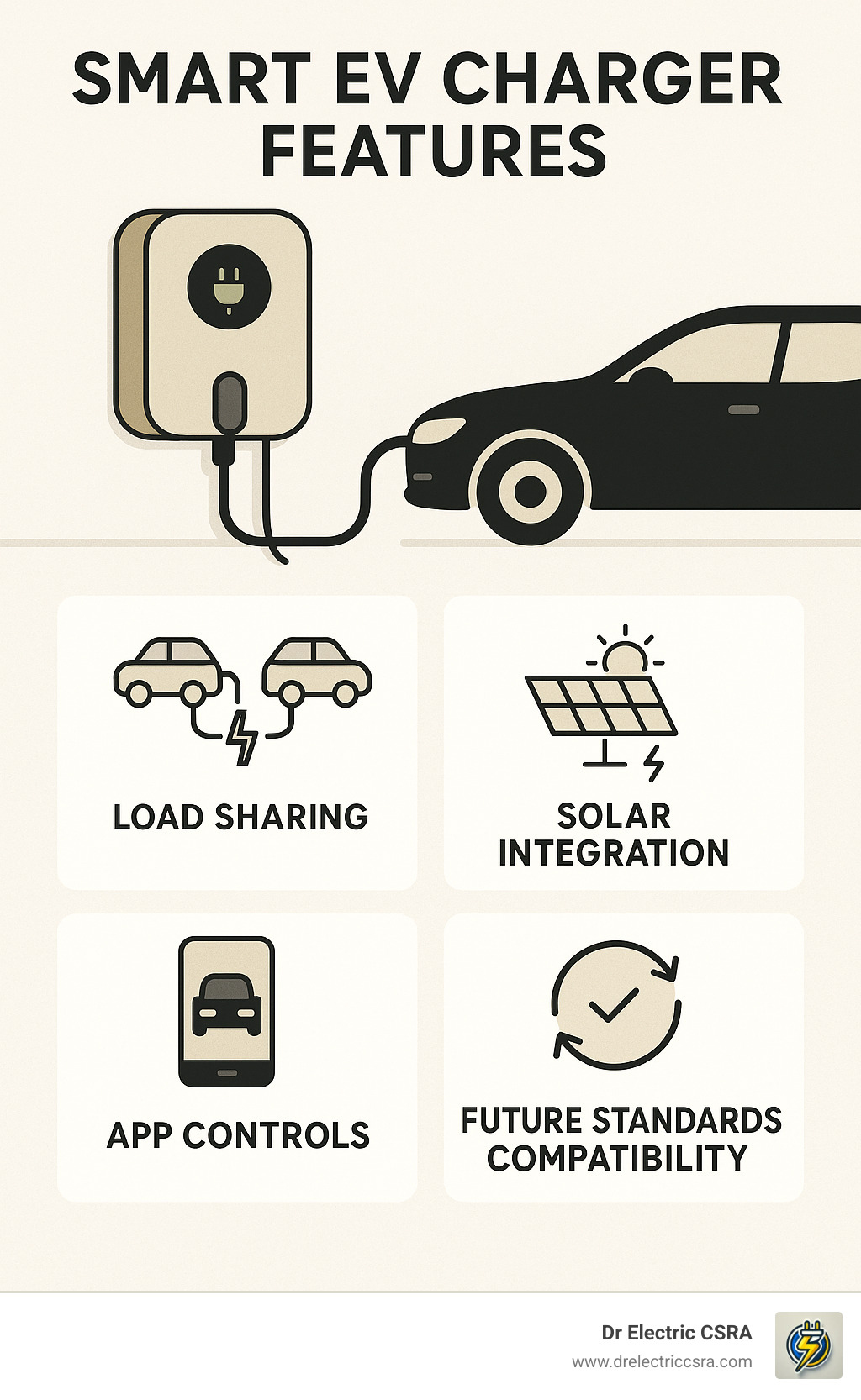Why Home EV Charging is Revolutionizing How We Power Up
An electric car charger for home is your gateway to convenient, cost-effective EV ownership. With over 80% of EV owners charging at home, it’s become the most popular and practical charging method available today.
Quick Home EV Charger Options:
– Level 1 (120V): Uses standard outlet, adds 3-5 miles per hour, costs $0-$500 to install
– Level 2 (240V): Requires dedicated circuit, adds 25-40 miles per hour, costs $500-$2,000 to install
– Smart Features: Wi-Fi connectivity, scheduling, energy monitoring, app control
– Installation Time: 2-6 hours with licensed electrician
– Federal Tax Credit: 30% of costs up to $1,000 through 2032
Home charging costs roughly one-third the price of DC fast-charging at public stations. The average driver covers about 40 miles daily – easily handled by overnight home charging on even a basic Level 2 system.
Think of it like charging your phone overnight and waking up with a full battery, except it’s your car that’s ready to go.
As Jesse Burnett, Master Electrician and founder of Dr. Electric CSRA, I’ve installed dozens of home EV charging systems across the Central Savannah River Area, helping homeowners choose the right electric car charger for home based on their driving habits and electrical capacity.

Electric car charger for home terms you need:
– EV charger load calculation
– transfer panel installation
– home EV charger vs public charging
How Home EV Charging Works
Think of your electric car charger for home as a smart middleman between your house and your car’s battery. When you plug in, your home’s electrical system delivers alternating current (AC) power to the charging station, which acts like a safety-conscious gatekeeper. It checks everything is working properly, then passes that power along to your vehicle where the magic happens.
Your car actually does the heavy lifting. The vehicle’s onboard charger converts that AC power into direct current (DC) that your battery can store. The charging station (technically called Electric Vehicle Supply Equipment or EVSE) is more like a really smart extension cord that makes sure everything stays safe.
You’ve got three charging levels to choose from, but honestly, only two make sense for your driveway.
Level 1 charging plugs right into any standard 120-volt outlet in your house. It delivers about 1 kilowatt of power, which translates to roughly 3-5 miles of driving range for every hour you’re plugged in.
Level 2 charging is where things get exciting. This requires a dedicated 240-volt circuit – the same type of power your electric dryer uses. It pumps out 6-19 kilowatts of power, giving you 25-40 miles of range per hour. That’s fast enough to fully charge most EVs while you sleep.
Level 3 charging (also called DC fast charging) delivers 50-350 kilowatts, but it needs massive electrical infrastructure that just doesn’t make sense for homes.
Safety comes first with home charging. All equipment must meet UL 2594 safety standards and SAE J1772 performance requirements. These ensure your system has proper ground fault protection, temperature monitoring, and safe disconnection protocols.
From Wall Outlet to Battery: The Journey
When you plug in your EV at home, electricity takes a carefully planned route from your electrical panel to your car’s battery. Your panel distributes power through circuit breakers that are sized to handle the continuous load safely. For Level 2 charging, we typically install a dedicated 40-50 amp circuit using heavy-duty copper wire.
The beauty of 240-volt power is simple physics – twice the voltage means twice the power delivery through the same wire size. That’s why Level 2 charging is so much faster than plugging into a regular outlet.
Circuit breakers need to be sized at least 125% of the charger’s continuous load. So if you have a 32-amp charger, you need at least a 40-amp breaker. This prevents annoying trips and keeps everything running smoothly for years.
Do I Really Need More Than Level 1?
Let’s crunch some real numbers. Say you drive 40 miles daily – pretty typical for most folks. Your EV needs about 12-15 kilowatt-hours to replace that energy. Level 1 charging at 1.4 kilowatts would need roughly 10-11 hours to get you back to full.
That works fine if you’re home for 12+ hours every day and never have surprises. But life happens, right?
Level 2 charging handles that same 15 kilowatt-hours in just 2-3 hours on a 7.2-kilowatt charger. This flexibility means you can top off during dinner, handle unexpected road trips, or even charge a second EV if needed.
Here’s a bonus: your battery actually prefers being charged to 80% for daily driving rather than always going to 100%. Level 2 charging gives you the speed to stay in that sweet spot of 20-80% charge for everyday use, while still having the option to fully charge for longer trips.
Choosing Your Electric Car Charger for Home
Picking the perfect electric car charger for home doesn’t have to feel overwhelming. After helping dozens of families across Augusta, Evans, Grovetown, and Martinez make this choice, I’ve learned that the right charger depends on how you actually live and drive.
Power output is where most people start, and for good reason. Home chargers range from 16 amps (about 3.8 kW) up to 80 amps (19.2 kW). Most homes can handle a 32 to 48-amp charger without major electrical work, which is plenty fast for overnight charging.
Here’s the thing though – your car’s onboard charger sets the speed limit, not your wall charger. Even if you install an 80-amp charger, your car might only accept 32 amps. Check your vehicle’s specs before going overboard on power.
Connector types used to be simple, but things are shifting. Most EVs today use the J1772 connector – that’s the round plug with five pins that’s been the standard for years. But Tesla’s NACS connector (North American Charging Standard) is gaining steam, with other manufacturers planning to adopt it.
The installation method affects both your upfront costs and long-term flexibility. Plug-in chargers use a heavy-duty outlet (like a NEMA 14-50, similar to what electric dryers use) and can be unplugged if you move. Hardwired chargers connect directly to your electrical panel and typically support higher power levels, but they’re permanent installations.
Weather protection matters more than you might think. NEMA 3R-rated chargers handle rain and snow just fine for most outdoor installations. NEMA 4 adds dust protection, which is overkill for most homes but required in some industrial areas.
Cable length typically runs 18 to 25 feet. I always tell customers to grab a tape measure and walk from their planned charger location to where they’ll park.
| Feature | Level 1 | Level 2 |
|---|---|---|
| Voltage | 120V | 240V |
| Amperage | 8-16A | 16-80A |
| Power | 1-1.9 kW | 3.8-19.2 kW |
| Range/Hour | 3-5 miles | 25-40 miles |
| Installation | Plug into outlet | Dedicated circuit |
| Cost | $0-$500 | $500-$2,000 |
Best Practices When Sizing an Electric Car Charger for Home
Future battery sizes keep getting bigger. Today’s EVs typically have 60 to 100 kWh batteries, but automakers are already announcing models with 150 to 200 kWh batteries. Sizing your electrical setup generously now means you won’t need expensive upgrades when you get your next EV.
Dual-EV households are becoming as common as two-car garages used to be. If there’s any chance you’ll add a second electric vehicle, plan for it during your initial installation.
Panel upgrade triggers include homes with 100-amp service or older, electrical panels with no available breaker spaces, or homes already running close to their electrical capacity.
Load management systems are like having a smart traffic controller for your electricity. These systems can effectively double your charging capacity without upgrading your electrical panel by automatically sharing power between chargers.
Smart vs Basic: Picking Features That Matter
Smart chargers with Wi-Fi connectivity offer benefits that go way beyond just plugging in and charging. The energy monitoring feature helps you track exactly what your EV charging costs and optimize your charging schedule to take advantage of time-of-use electricity rates.
Scheduling features automatically start charging during the cheapest electricity periods, potentially saving 30 to 50% on your charging costs. Some local utilities offer special EV rates with lower overnight pricing, and smart chargers make it effortless to take advantage of these programs.
Over-the-air updates keep your charger current with new features and evolving standards. This future-proofs your investment as EV technology continues advancing rapidly.
Utility demand-response programs are becoming more common, where utilities pay you small amounts to reduce charging during peak demand periods. Smart chargers can participate in these programs automatically, potentially earning credits on your electric bill.
According to ENERGY STAR research, smart charging features can reduce overall energy consumption by optimizing charge timing and managing electrical loads more efficiently throughout your home’s electrical system.

Installation & Cost Breakdown
Let’s talk real numbers. Installing an electric car charger for home isn’t just about buying a box and plugging it in. After installing dozens of EV chargers across Augusta, Evans, and the CSRA, I can give you a realistic picture of what you’re looking at cost-wise.
Quality Level 2 chargers typically run $400-$700. The $400 units are solid, basic chargers that’ll do the job reliably. The $700-$1,000 smart chargers give you all those Wi-Fi features and energy monitoring we talked about earlier. Always choose UL-listed equipment from manufacturers you’ve heard of.
Labor costs depend entirely on how cooperative your house wants to be. If your electrical panel is nearby and we can run wire easily, you’re looking at 2-4 hours of work at $75-$125 per hour. But if your panel is on the opposite side of the house from your driveway, that 2-hour job becomes a 6-8 hour trip.
Permits and inspections add another $50-$300 to your total, depending on your local municipality. We handle all the paperwork and scheduling so you don’t have to figure out which forms to fill out.
Here’s where things can get expensive: panel upgrades. If your home has 100-amp service or your panel is already packed full of breakers, you might need an upgrade. These run $500-$2,500 depending on complexity.
Now for the good news about money. The federal tax credit covers 30% of your total costs – equipment, installation, electrical upgrades, the whole shebang. It’s capped at $1,000 and runs through 2032. Many utilities sweeten the deal with additional rebates of $200-$500.
If you’re in a condo or apartment building, check out the federal Zero-Emission Vehicle Infrastructure Program for additional funding opportunities.
Steps a Licensed Electrician Follows
Every proper EV charger installation follows the same systematic approach. We start with a comprehensive site survey – basically, I come out and poke around your electrical panel, measure distances, and figure out the best path from point A to point B.
Load calculations come next. This isn’t guesswork – we actually calculate whether your existing electrical service can handle the additional load safely.
Running the dedicated circuit is where the real work happens. We install a new breaker sized appropriately for your charger, run the right gauge wire (usually 8 or 6 AWG for most installations), and make sure everything is properly protected in conduit where required.
Mounting and testing includes securing your charger in the perfect spot, making all the final connections, and thoroughly testing every safety system. We verify proper grounding, make sure the GFCI protection works correctly, and test the communication between your charger and vehicle.
Final inspection wraps everything up. We coordinate with local inspectors, provide all necessary documentation, and make sure your installation passes with flying colors.
Budgeting: What Will My Electric Car Charger for Home Really Cost?
Let me give you three realistic scenarios based on actual installations I’ve completed in the CSRA.
Basic installations run $800-$1,400 total when everything aligns perfectly. Your panel has space, it’s reasonably close to where you park, and we can run wire without major obstacles. These represent about 60% of our installations.
Moderate complexity installations cost $1,200-$2,000 and cover situations where we need longer wire runs, outdoor conduit work, or minor panel modifications.
Complex installations can reach $2,500-$4,000 when major electrical work is required. This includes new service panels, meter upgrades, or situations where your existing electrical system needs significant modifications.
Here’s the math that makes it all worthwhile: that 30% federal tax credit significantly reduces your actual cost. A $1,500 installation only costs you $1,050 after the credit. Even a $2,000 installation drops to $1,400 out of pocket.
Smart Features & Future-Proofing
Your electric car charger for home is more than just a power outlet – it’s a smart device that keeps getting better. Modern chargers receive over-the-air firmware updates just like your smartphone, adding new features and capabilities without replacing hardware.
Bidirectional charging represents the next frontier in home energy management. While still emerging, this technology lets your EV battery power your home during outages or even sell electricity back to the grid during peak pricing periods.
The ISO 15118 standard is revolutionizing how we interact with charging stations. Soon, you’ll simply plug in your car and everything happens automatically – authentication, billing, even optimizing charge rates based on your preferences.
For households planning multiple EVs, load-sharing systems are game-changers. These smart devices let two chargers share a single high-capacity circuit, automatically managing power distribution based on each vehicle’s needs.
Solar integration becomes seamless with the right smart charger. The system can prioritize using your solar panels to charge your EV during sunny days, maximizing your renewable energy investment and minimizing grid electricity usage.

Staying Ahead of Standards
The charging connector landscape is shifting rapidly. NACS (Tesla’s charging standard) is becoming the North American standard, with major automakers adopting it for 2025 and later models. This doesn’t mean your current J1772 charger becomes obsolete – quality adapters bridge the gap effectively.
When installing your electric car charger for home, we recommend choosing equipment with adapter compatibility or planning for easy future upgrades. Installing proper conduit and wiring infrastructure now makes swapping chargers later much simpler and less expensive.
Planning conduit during initial installation provides tremendous flexibility. We often install slightly oversized conduit that can accommodate larger cables for higher-power charging as technology advances.
Dual-Charging Without Panel Upgrades
Many CSRA homeowners ask about charging two EVs without expensive electrical panel upgrades. Load-sharing devices make this possible by intelligently managing power between chargers.
These systems continuously monitor each vehicle’s charging needs and adjust power allocation in real-time. If one car finishes charging, the system automatically gives full power to the second vehicle.
Power-splitting algorithms ensure both vehicles receive adequate charging while respecting your home’s electrical limitations. The system might give each car half power simultaneously, or alternate between them based on battery levels and departure times you’ve programmed.
As Jesse Burnett from Dr. Electric CSRA, I’ve helped many families transition from one EV to two without major electrical upgrades. The key is choosing the right load management system and sizing your initial installation with future needs in mind.
Frequently Asked Questions about Home EV Charging
How long does it take to charge at home?
The answer depends on three main factors: your charger’s power output, your car’s battery size, and how empty the battery is when you plug in.
Level 1 charging (your regular wall outlet) takes 12-24 hours for a complete charge from empty. That sounds scary, but you almost never need a full charge for daily driving.
Level 2 charging with a dedicated electric car charger for home completes most EVs in 3-8 hours from empty to full. But for typical daily use, you’re usually just topping off from 20% to 80% capacity, which takes only 2-4 hours.
A 30-amp Level 2 charger adds roughly 30 miles of range per hour. So if you drive 40 miles to work and back, you’ll replace that energy in about 90 minutes of charging while you’re having dinner.
Most EV owners quickly realize they think about charging differently than gas fill-ups. Instead of going from empty to full occasionally, you’re adding a little bit most nights – like charging your phone.
Can renters or condo owners install a charger?
This is one of the most common questions we get, and the good news is that options are expanding rapidly. Many states now have “Right to Charge” laws that protect renters with designated parking spaces. These laws typically require you to notify your landlord or property management, but they can’t unreasonably deny your request.
Condo owners usually have more installation rights since they own their unit, but you’ll likely need approval from your homeowners association or condo board. The key is presenting a professional installation plan that addresses safety and doesn’t affect common areas.
For apartment buildings and condos, there’s even better news. The federal Zero-Emission Vehicle Infrastructure Program provides substantial funding for shared charging infrastructure in multi-unit buildings.
Do I need to buy a separate charger if my car includes a portable cord?
Every EV comes with a portable Level 1 charger that plugs into any standard outlet – it’s like the charging cable that came with your first cell phone. It works, but you’ll quickly understand why most people upgrade.
The portable charger is perfect for emergencies or occasional use when visiting friends or staying at hotels. But for daily home charging, it’s painfully slow and not very convenient.
A dedicated electric car charger for home offers several advantages beyond just speed. Smart features like scheduling, energy monitoring, and smartphone apps make charging effortless. You can set it to start charging at midnight when electricity rates are cheapest, or track exactly how much your driving costs.
Durability is another factor. Portable chargers wear out faster from constant plugging and unplugging, weather exposure, and being stored in your car. A permanently installed charger is built for daily use and typically lasts much longer.
Conclusion
Installing the right electric car charger for home is like upgrading from dial-up to high-speed internet – once you experience the convenience, you’ll wonder how you ever lived without it. Whether you choose a simple Level 2 charger or a feature-packed smart system, home charging transforms daily EV ownership from a planning exercise into pure convenience.
Here in Augusta, Evans, Grovetown, Martinez, and throughout the CSRA, we’ve seen how home charging changes everything for EV owners. No more hunting for public chargers or waiting in line. Just plug in when you get home and wake up ready for whatever the day brings.
As a Master Electrician with over 1,200 jobs under my belt, I’ve learned that proper planning and professional installation make all the difference. Every home has unique electrical characteristics, and cookie-cutter solutions rarely work best. That’s why we start every project with a thorough assessment of your electrical panel, your driving habits, and your long-term plans.
Safety comes first in everything we do. All our installations exceed code requirements and include comprehensive testing to ensure your family’s protection. We handle the permits, coordinate inspections, and provide the documentation you need for tax credits and insurance purposes.
The 30% federal tax credit makes this an ideal time to invest in home charging infrastructure. When you factor in the daily savings compared to public charging stations, most homeowners see their investment pay for itself within two years. Add in the convenience factor, and it’s really a no-brainer.
Our commitment doesn’t end when we pack up our tools. We provide 24/7 emergency support because electrical issues don’t wait for business hours. Whether you have questions about your new charger or need troubleshooting help months later, we’re here to help.
Ready to join the home charging revolution? Let’s start with a conversation about your specific needs and electrical setup. We’ll recommend the perfect electric car charger for home solution and provide a detailed quote with no surprises.
More info about EV charger installations






0 Comments